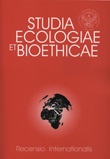Wpływ dżdżownic na zespoły skoczogonek (Collembola) w uprawach trawiastych jedno i wielogatunkowych
The impact of earthworms on collembolan (Collembola) communities in grass mono- and polycultures
Author(s): Grzegorz Makulec, Izabela OlejniczakSubject(s): Geography, Regional studies, Environmental Geography
Published by: Wydawnictwo Naukowe Uniwersytetu Kardynała Stefana Wyszyńskiego w Warszawie
Keywords: earthworms; springtails; species diversity; grass onoculture; grass polyculture
Summary/Abstract: In 2004-2005 a lysimetric experiment was designed to determine whether and how plant diversity and earthworms could influence diversity and densities of collembolan communities. We compared two grass cultures: monoculture of Festuca rubra L. and a polyculture, the mixture of grasses (8 species) commonly used in agriculture. In addition to two plant communities of different diversity, we used in our experiments an engineering species of earthworm – Aporrectodea caliginosa (Sav.). The experiment was initiated in May 2004, when the lysimeters were sown with F. rubra or with a mixture of grasses. The following year, in May 2005, we introduced 6 individuals (that correspond with average densities of 200 ind.m-2 in natural environment ) of A. caliginosa to half of the lysimeters. In experiments we used plastic lysimeters, 450 cm2 in area and 20 cm high, filled with alluvial coarse sandy soil. The same soil was used in environment of the lysimeters. Soil samples were taken at the depths of 0-5cm, 5-10cm, 10-15cm and 15-20cm, before introducing earthworms and after 60, 120 and 180 days from introducing earthworms. On each occasion, samples were taken from six or ten lysimeters in each variant of the experiment. Soil samples were taken from central parts of lysimeter to avoid the edge effect. Springtails were extracted in the Tullgren’s apparatus and then were determined basing on Stach’s (1955) and Fjellberg’s (1998, 2007) keys and taxonomic paper of Rusek (1982). For statistical analysis we used nonparametric tests. Species diversity of Collembola communities was calculated according to Shannon-Wiener equation using logarithms at a base of 2 (Shannon and Wiener 1963). Hutcheson’s test was used to determine the statistical significance of differences between the H indices (Hutcheson 1970). Three ecological groups were distinguished among collembolans basing on their preference to soil layer: epigeic, hemiedaphic and euedaphic (Christiansen 1964). We found that soil layer (Kruskal-Wallis test: N = 432, H=18,25, P=0,0004), biodiversity of grass culture (N=432, H=14,59, P=0,0001) and the period of the season (N=432, H=24,24, P=,00000) had an important effect on densities of collembolan communities independently of earthworms presence (N=432, H=1,99, P=0,16). We found 18 species of springtails and the number of species decreased with soil layer. The most abundant were Cryptopygus bipunctatus and Isotomodes productus.
Journal: Studia Ecologiae et Bioethicae
- Issue Year: 12/2014
- Issue No: 3
- Page Range: 83-97
- Page Count: 15
- Language: Polish

